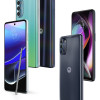Review: LG VX-8100
For a 1.3MP camera, something still relatively new to the US market, the LG's photo abilities leave a lot to be desired. Things start out well enough, as the photo application is easy to manage like most of the Verizon UI. The capture screen contains a large status bar, displaying flash, zoom, and resolution information. While zoom can be manipulated directly from the capture screen, resolution must be adjusted through a separate menu screen. The phone's flash can be turned on or off through a separate menu and with the side select button, though because the viewfinder lacks any indication of this, we only discovered the latter method after looking closely at the button's icon.
Photos are taken in landscape mode (1200 wide by 960 tall), however the phone lacks any way to adjust this in software, and so shooting portraits requires a counter-intuitive 90-degree rotation of the phone. The available image effects include normal, sepia, black & white, negative, and solari (more commonly known as posterize). When gripping the phone to take pictures, the capture button under where our thumb naturally fell. However the low position of the camera lens caused frequent trouble; our index fingers occupied the bottom edge of the photo frame, which forced an adjustment of our grip on the phone.
From pressing the photo button to when the application is launched and ready to shoot is just about three seconds. After shooting, saving a picture causes a second and a half wait, before a save confirmation dialog appears, and then returns to the capture menu. Through this process however, we encountered a number of problems. First, from the shutter sound to when the photo is actually captured is about a second. This means that pressing the shutter button, hearing the shutter sound, and then moving the camera resulted in blurred photos. The second issue is that there is no auto-save function, so leaving the photo app or closing the phone jettisons the captured photo.
Finally and most important was the basic quality of images the camera produced. The lack of detail and sharpness, even at the phone's maximum 1200x960 resolution, isn't readily apparent on the phone's display. However once the image is moved to your computer it is decidedly hard to appreciate. The images lack sufficient exposure, with most of the colors buried under darkness which can only sometimes be rescued in a photo editor.
The default send format is Verizon's pix message as either MMS or email, both of which use the same quick and painless messaging interface. Secondary transfer abilities include posting a photo to the Verizon Pix Place website, or moving a photo onto a mini SD card.
Capturing video on the phone is an equally lackluster experience. Video quality is choppy, and there are moments where the capture is paused before regaining motion. The audio playback is on par with the quality on a voice call. Video is recorded at 176x144 resolution in 15 second clips. Both the resolution and length felt arbitrarily small considering the mini SD storage abilities of the phone. The net result: What we shot was entertaining on the phone, but low resolution doesn't hold up once the clips were transferred to our computer via mini SD.
While there is no video editing available in the phone (nor any special effects like what are available for still photos), white balance and lighting adjustments are available, but lacks the special effects of still photos.















 CTIA 2005
CTIA 2005
 iPhone 15 Series Goes All-In on USB-C and Dynamic Island
iPhone 15 Series Goes All-In on USB-C and Dynamic Island
 Motorola Adds 5G to its 2022 Mid-Range Lineup
Motorola Adds 5G to its 2022 Mid-Range Lineup
 Blu Gets Into US 5G with the Bold N2
Blu Gets Into US 5G with the Bold N2
 Apple Watch Goes Ultra
Apple Watch Goes Ultra
 LG VX-8100
LG VX-8100








